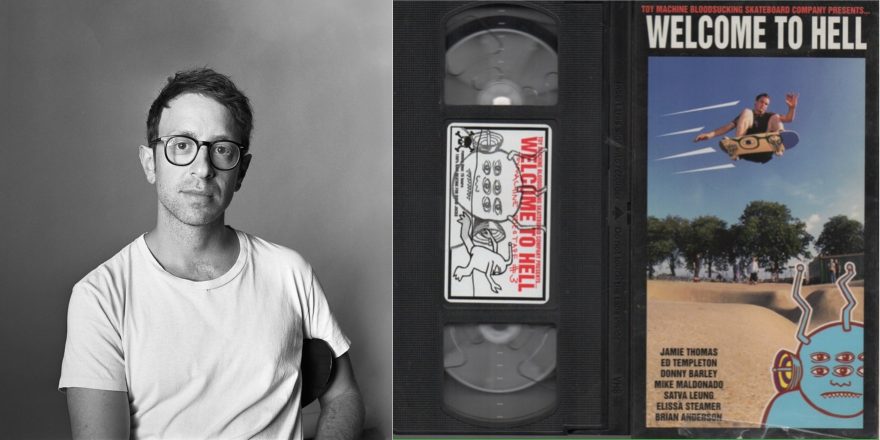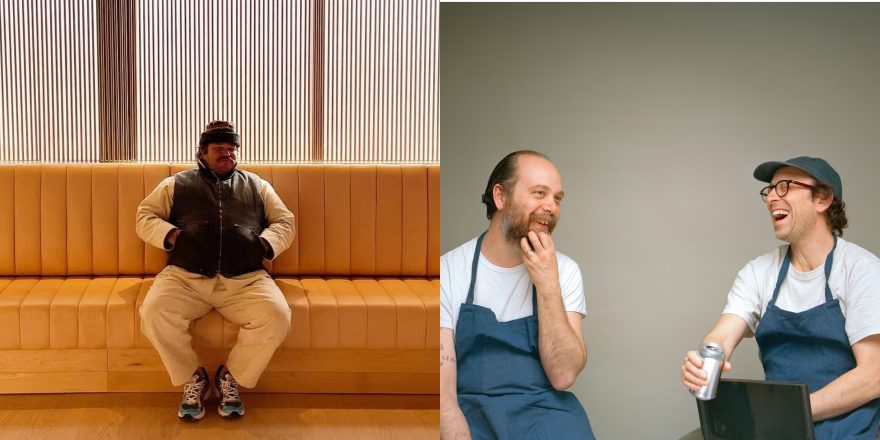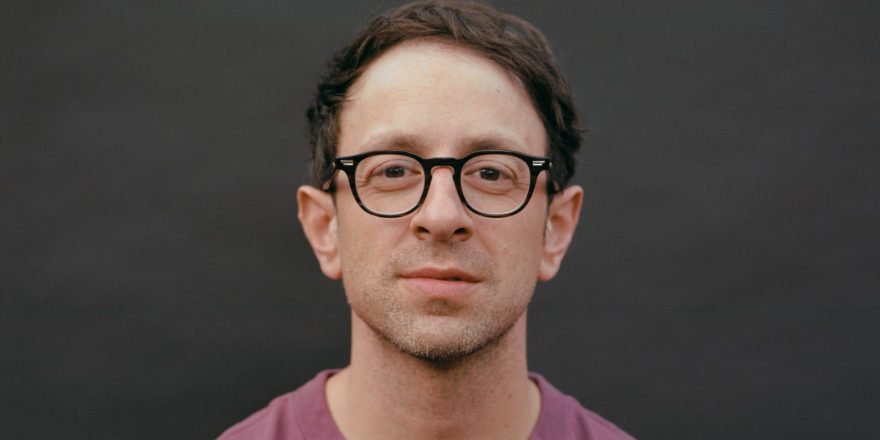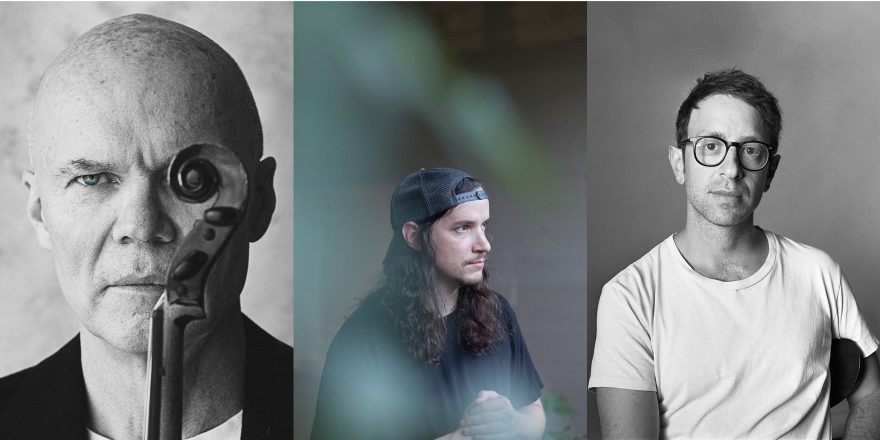I don’t remember the first time I saw Welcome to Hell, but I know where I was. I grew up in a small town in Ontario called Bolton, and my friend Matt Wise lived across from a school that was also a really good skateboard spot. So, his house was always the place. We would be in his basement all summer, and just out skateboarding. (We had these terrible spots in Bolton and we would film there. Once we got our licenses, we would drive out to spots in Toronto or by the airport — we would drive around industrial parks looking for new places to skate.) Matt was the one who got the video, and I remember we just watched it over and over and over again.
At the time, it was just so gnarly. The tricks were bigger than anything we’d ever seen before. I think until then, I’d not seen a skateboard video that felt punk. It was super DIY, the soundtrack was pretty heavy, and the style of skating was just way more aggressive. But then, everything was more aggressive. You had these shots of this dystopian American hellscape to start it off, with Jello Biafra singing, and then there were all these shots of just how much people hate skateboarders — all these people telling them to fuck off and trying to hit them or steal their boards. It had this us-versus-the-rest-of-the-world feeling, which at the time really appealed to me. And the skateboarding itself was just so aggressive. You had Jamie Thomas doing these crazy lines; shirtless, shaved head, doing these massive backside 180s over these really big rails, and just ripping down restaurant promenades, doing tricks amongst people eating. It was gnarly.
All of the songs fit perfectly, and I think it’s seared into a lot of people’s subconscious. Welcome to Hell was the first time I heard Danzig. I think it was also the first time I heard the Jello Biafra sing; that Lard song was the intro to the video, and I remember at the time just being like, What the fuck is this? I loved it. And Elissa Steamer skating to the Sundays — I don’t know if it’s talked about a lot, but that was the first ever female pro skate part ever. And it wasn’t tokenistic, it wasn’t a throwaway. That team was really interesting. It was a really eclectic mix of people, and Toy Machine really had a lot of foresight in picking skaters that I think ended up having a long career in the sport.
I got the idea for this record when I was out walking, which is often how I get ideas for records. It’d been a while since my last record, and I was like, You know what? I’m ready to make a new album. But I didn’t really know what to do. Then I thought about that cliched expression, “write what you know,” which I’d done with previous records; I’d done concept albums before, but they’d been pretty heavy emotional stuff, and I didn’t want to do that. I wanted it to be much lighter and joyful. I was like, What do I really like these days? What’s the thing I’m constantly engaging with? And it’s basically just skateboarding. My wife makes fun of me because, after the kids go to bed, I just sit down at the TV and — I have one of those voice-controlled remotes — I push the button and say, “Thrasher skateboarding YouTube.” Then I watch whatever skate film comes up. So I was like, I wanna make a skateboard album! How could I possibly engage with skateboarding in a way that felt cool? Then I was like, I know Welcome to Hell pretty well, it’s been a minute since people really talked about it. What if I just rescored it? So once I realized that would be a fun thing to do, I knew it was the right thing to keep chasing.
Here’s the way I see skateboarding and jazz intersecting: If you look at jazz as a musical language, and where it started and where it’s gone, I think you can see this progression, in the way that people have taken what came before them and expanded upon it. You have this shared language, too — in Western music, you have the 12 notes in a scale or the 12 tones on a keyboard as this base. Then you have the American songbooks of all these old showtunes that jazz reappropriated into jazz standards, and twisted and morphed throughout time until it becomes something totally different. In jazz, what made you stand out as a player was, one, your ability to play, but also finding a unique voice within the genre. It wasn’t enough to just be able to sing a song or play a saxophone; you had to have a very unique style and way of interpreting melody or improvising. Each player takes the contributions from other players before them and says, “That’s cool, I wanna learn it. And here’s how I’m gonna twist it into something that feels more authentic to me.” And then over time, you have this really wild and cool progression.
With skateboarding, I think it’s really the same. You have the original skateboarders who were just carving, using the skateboard like a surfboard on concrete. But then you had the freestyle skateboarders that came out of that, then the street skaters that came out of freestyle and halfpipe skating. There’s a shared group of tricks that everyone learns how to do, but what makes you interesting and unique as a skateboarder is how you take those tricks and expand upon them. What variations can you do, what different grinds can you do, what tricks can you do into a grind or a slide? And then you also have the added aspect of architecture and landscape — you have this whole world of architecture and cityscape and concrete, and I think the most creative skaters are able to see that landscape and say, “I wanna do this trick on this thing.” And the ones that are the most creative find really wild and innovative ways to reinterpret landscape to fit their skateboarding. To me, that’s the same as jazz, where it’s a shared language that’s being expanded upon and reinterpreted and just constantly evolving.
In composing a jazz score for Welcome to Hell, I didn’t think about the original soundtrack at all. Because those songs are canonized — people know them so well. So I wanted to do something where people would be like, Woah, what the fuck is that? Why would he have done that?
The only things that I knew that I really wanted to explore were longer, through-composed melodies, like melodies that never repeated. So there was never a chorus or a verse, it was just these longer melodies that built and expanded on themselves. And I was so certain that it was going to be saxophone and trumpet, but then I did it and it sounded really bad, so I ended up tweaking the instrumentation of those melodies. But I think that concept was the only thing I started with that ended up making it on to the rest of the record. Everything else was just kind of like, What am I feeling? What feels right? And then going from there.
Scoring a skate video is very different than writing to the emotional mood of a scene in a narrative film. But I took that general idea of scoring to picture from all of the scoring work that I’ve done, and rather than asking, What’s the emotional mood of the scene? I approached it as, What’s the emotional mood of the skater? I knew those parts so well, so it was like, How does this person skateboard? Is it aggressive? Is it creative? Is it playful? Is it angry or relentless? Then I think the decision became, Do I do it on the nose? Like for the Jamie Thomas part — his part is the most aggressive, relentless part in the whole video, so I want to make a song that sounds exactly like that. But then for Donny Barley’s part, who I think is this incredibly creative, I wanted to subvert it. I wanted to see this really aggressive skate style set to something that feels super ethereal and open, and see how that juxtaposition worked. So ultimately, it’s approaching it from the same place, but with the skateboard video, it’s much less literal than it is with a film.
Right after I came up with the idea, I realized that I can’t release the footage without permission; otherwise, the whole concept is kind of dead in the water. I’ve been following Ed Templeton for years, because I love his photography and he’s a childhood hero for sure, both as a skateboarder and an artist. So I just DMed him, and the next day, he wrote me back. I was like, Holy shit, Ed Templeton is in my inbox!
He was so supportive. Not only did he let me use the footage, but he contributed album art, which is crazy. The fact that this guy who is totally a hero of mine was both supportive of the project, and a mensch who contributed album art, felt really encouraging. It was such a treat to talk with him, get his perspective on things, and have him listen and know that he was into it. I think the music is probably not what he listens to, given what I’ve gathered of his taste from all of the videos that he’s done — I think he listens more to punk and heavier music. But I know he appreciated the song I wrote for his part, because it’s a real nod to Sonic Youth and wonked out weirder shit.
Something new that I saw in the footage that I think is really cool — and it’s something I could have never seen when I was younger — but you watch that video now, and, like, eighty-five percent of the tricks in that video would be throwaway for a skateboarder now. They just would never even make it into a film. And what I realized was that they invented that. At the time, everyone’s minds were blown, and all of these young skateboarders looked at it and were like, Holy shit, that’s possible. I can do that. And they went out and expanded upon it. So at this point, with close to 30 years of distance, I looked at it and was like, Wow. At this point, all of this stuff is basic, but watching it through the lens of knowing this was the first time it was being done — and what a profound impact it has had on skateboarding since then — made me have a lot of reverence and appreciation for those skaters who basically pioneered this stuff, that everyone then copied and did better. It was just cool to watch it through the lens of knowing that they started it, and knowing what’s come since because of what they did. It just made me so stoked for the fact that it exists.
As told to Annie Fell.







